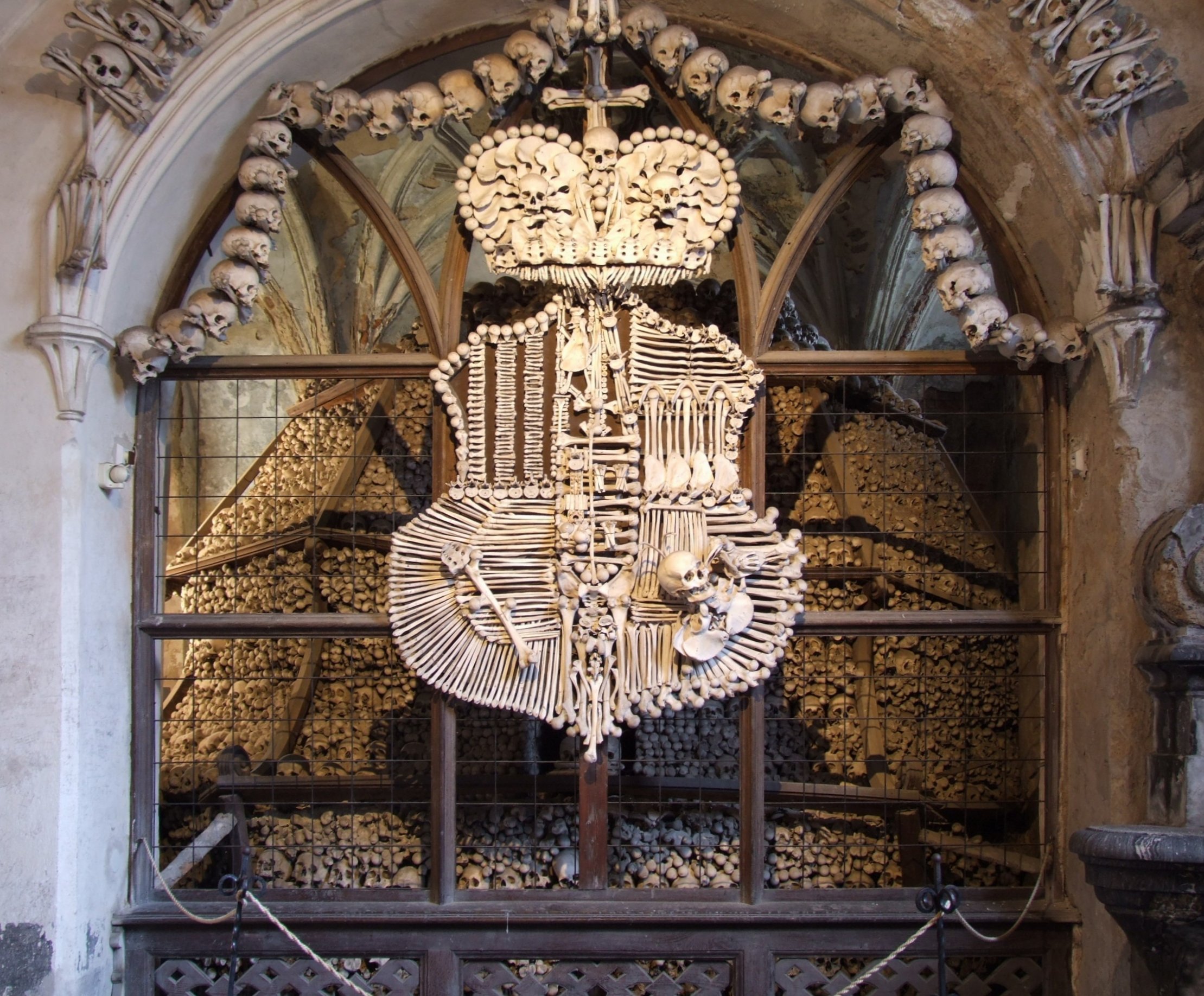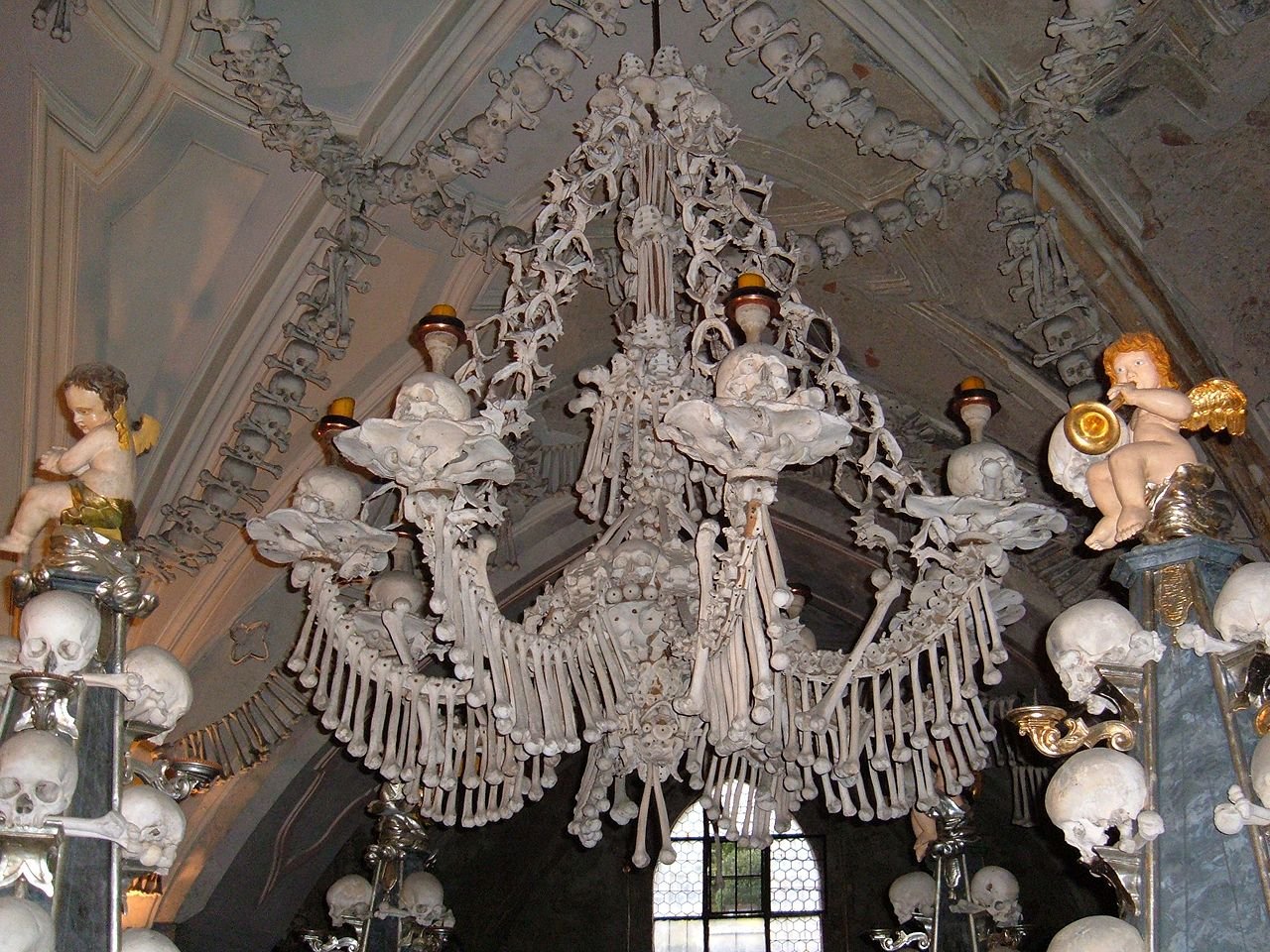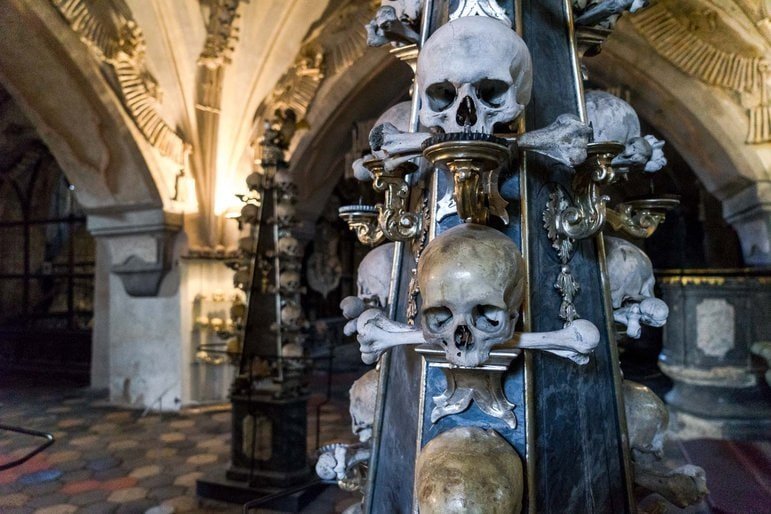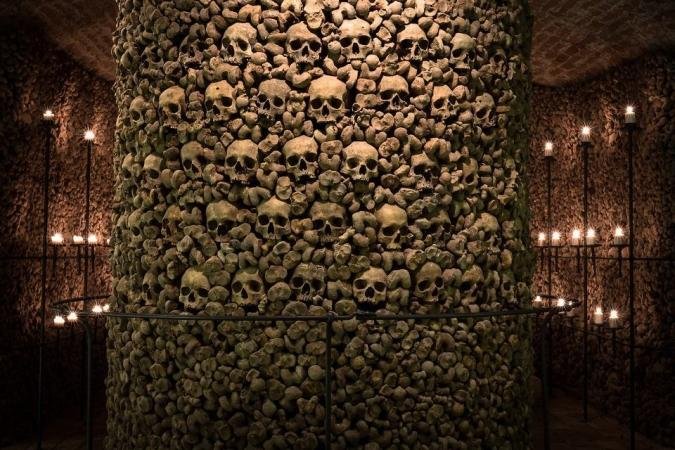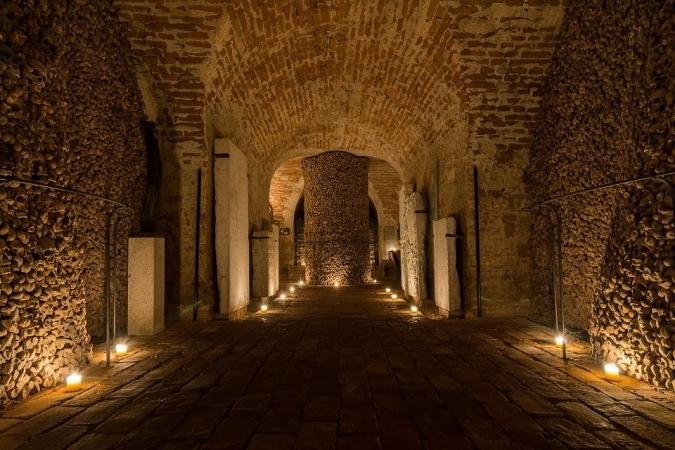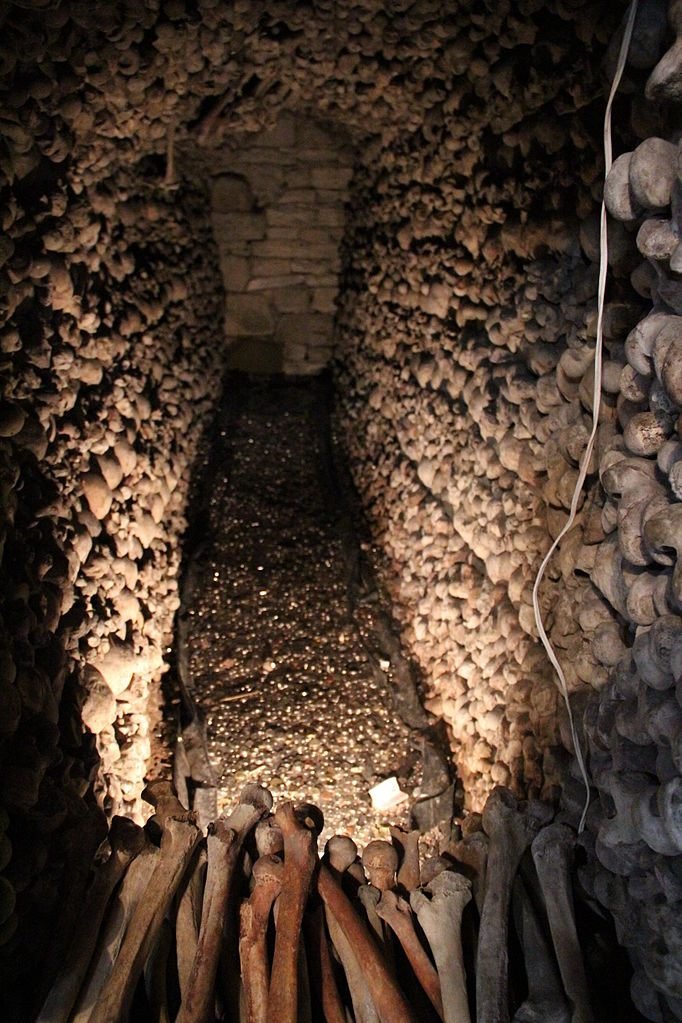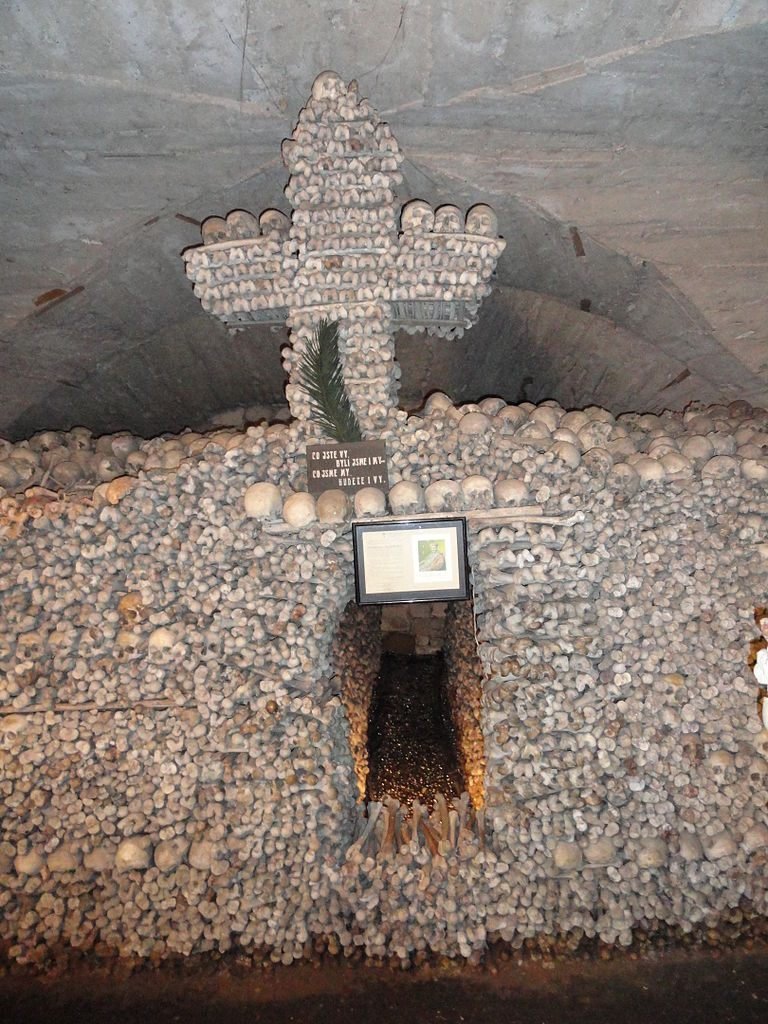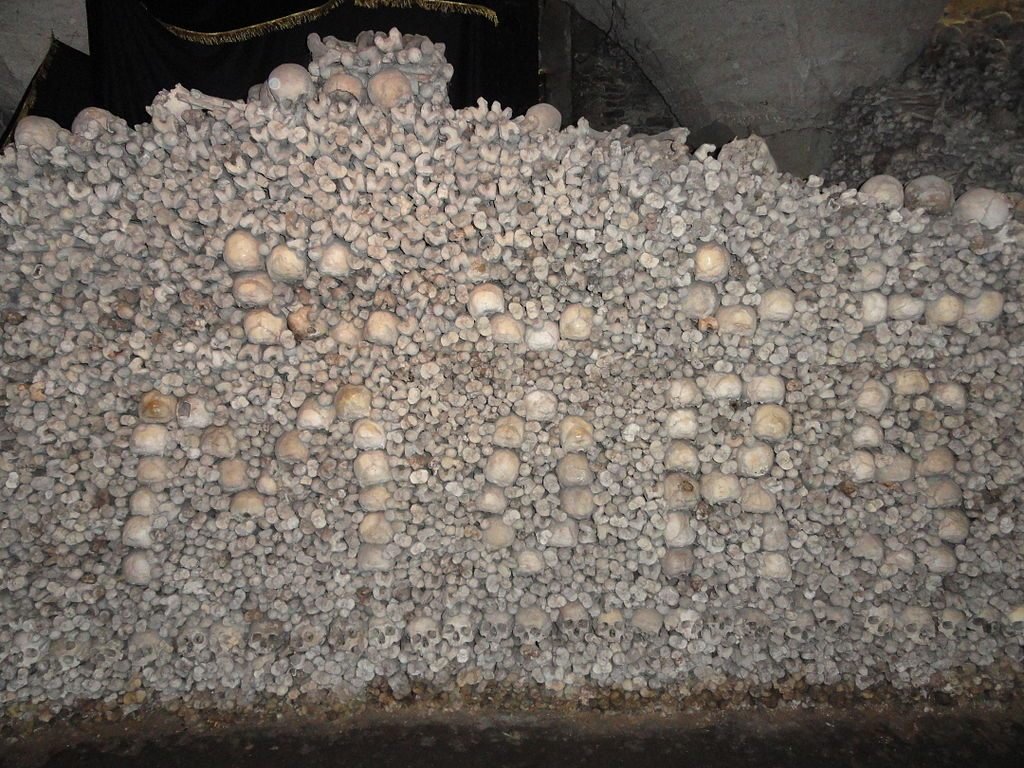The Ossuaries of the Czech Republic
Ossuaries are a form of burial practice where the bones of the deceased are typically placed in a box, chest, or stack as a final resting place for the dead when burial space is sparse. The deceased is given a temporary burial, and after several years of allowed decomposition, they are placed within these ossuaries to make room for the recently departed. Ossuaries allow more space for the deceased to rest than a typical coffin burial. The Czech Republic is known for its unique ossuaries, one of which is the second-largest in the world after the Paris Catacombs.
The Sedlec Ossuary
In the suburb of Kutná Hora, located in the Czech Republic, stands a unique oddity, the Sedlec Ossuary, or the Church of Bones. The outside of the church appears to be similar to other medieval Gothic churches of the 12th century. However, its interior is what differs from other chapels.
In the late 12th century, it is believed that Henry, the male abbot and head of the Cistercian monastery in Sedlec, was sent to the Holy Land in Palestina on a mission by King Ottokar II of Bohemia. His mission was to bring back the earth from Golgotha, where Jesus was crucified, and spread the earth among the church grounds. The church cemetery became a popular place to rest due to rumors spreading about the sacred act performed by Henry. The popularity of being buried in the cemetery blessed with holy soil significantly increased in the 14th century, as many who fell victim to the Black Death (bubonic plague) requested to be moved there in their final days. The sudden influx of bodies caused the church to expand, building a gothic chapel with a lower chapel to serve as an ossuary to accommodate the mass graves.
According to legend, in the 15th century, a half-blind man was tasked with exhuming the deceased's bones and stacking them neatly in the ossuary. After many years of the chapel being undisturbed, an artist named František Rint, also a wood carver, was hired by the Schwarzenberg family in the 1870s to create an order with the deceased skeletons. The result produced one of the most unique churches in the Czech Republic, yielding about 200,000 visitors annually.
Inside the ossuary are 40,000 to 70,000 skeletons that local woodcarver František Rint has artistically arranged. Visitors can also see the signature left behind by the artist in human bone. Inside can be seen towers of bones, which are believed to honor the dead. Also inside are chandeliers with bones hanging down to emulate flowing crystals and skulls to help hold the candles up. The most famous artifact is the Schwarzenberg coat of arms made of bone, which belongs to the same family that hired the artist. After touring the Sedlec Ossuary, visitors may purchase skull souvenirs from the gift shop. Unlike the real human bones in the rest of the church, the souvenirs are made of plaster.
Ossuary of St. James in Brno
The ossuary is located underground in Brno, Czech Republic, beneath what is now the city center square of Jakubské náměstí. It was initially beneath the Church of St. James but was eventually torn down and paved over 200 years prior. It was rediscovered in 2001 during a land survey, despite the church having been around since the 13th century. While they were aware to some extent of its existence, they underestimated how far the Ossuary had expanded. The Ossuary was built when the Church of St. James could not expand due to being within city walls that prevented its growth, and it is the second largest Ossuary in Europe.
About 50,000 bones are located in the ossuary. Some of the neatly stacked corridors of bones have become jumbled due to flooding and mud. According to anthropologists, some of the remains are the victims of the plague, the Thirty Years' War, and the Swedish siege. Bones that are tinted yellow have not seen sunlight, while those that present a deeper yellow are cholera victims. Reddish bones are typically associated with victims of the plague.
Křtiny Ossuary
This ossuary is located in Moravia at the Church of the Blessed Virgin Mary, with approximately 1,000 sets of remains. While this ossuary is relatively tiny compared to others, this ossuary offers two unique finds. The bones are believed to originate from the old Krtina cemetery and were eventually relocated to the Church of the Blessed Virgin Mary, as the burial site was affected by the church's construction in the 1820s. While the ossuary existed for many years, it was rediscovered in 1991, as after the bones were placed inside, the entrances were sealed shortly after, leaving the burial site forgotten. Upon its rediscovery, they found the builder/founder of the temple's remains, Abbot Matuška. He was reburied in a decorative copper box and placed in front of the altar of St. John and Paul.
The unique aspects of this ossuary are its decorative skulls and helpful insights into medical science. This is the only ossuary with skulls painted with black-dyed laurel wreaths and others with "T" markings. About 12 skulls show these painted markings, some believing this is a tradition passed down by wealthy Austrians sometime in the 17th century. Another unique find is that, according to studies, some of the skulls have presented benign tumors and evidence of malignant tumors. Osteologists have examined these remains to help better understand how they formed, giving insight into these diseases' development.
Putim Ossuary
Located behind the medieval St. Lawrence church and built-in 1741, the Ossuary is believed to contain the remains of soldiers from the War of the Austrian Succession (1740–1748). However, most of the history behind this ossuary remains a mystery.
While it is widely believed that most of the remains come from the Austrian Succession, many think there is another possibility of where the remains came from.It is theorized that the remains were transported from multiple cemeteries to the Ossuary when room became sparse as the lower section of the church was not expanded until around 1875.
In 1829, Minister Ondřej Zloch carefully stacked and laid out the bones. Although deteriorated, visitors who explore the ossuary can see a wooden cross surrounded by thousands of skeletal remains. If one is lucky, one might also see the mysterious tricorn hat. Legends of a three-pointed army hat with a feather (tricorn hat) shroud this ossuary. According to the locals in the nearby town of Pisek, the hat appears on a particular skull. If someone attempted to move the hat, it would return to its original place. According to eyewitnesses, this hat did exist, as it is present in Vilém Munzar's photograph from 1915.
Mělník bone church
Beneath St. Peter and St. Paul's church in Mělník originally lay a crypt for Bohemian queens and princesses. Adjacent to the church is the Mělník chateau, which originated from the Přemyslid castle, where many royal ladies (believed to be 23) once lived.
Due to the plague epidemic that ravaged the 1520s, the demand for burial grounds increased dramatically. Around 15,000 remains were cleaned and placed within the royal crypt to compete with the influx of plague victims. At this time, the crypt was unorderly as bones were piled together. In the 1780s, ossuaries were declared a health risk, as many were victims of plagues or other diseases. Due to this, the now-ossuary below St. Peter and St. Paul's church was sealed and forgotten for 230 years.
In 1910, a Czech anthropologist and university professor named Jindřich Matiegka reopened the ossuary. Jindřich Matiegka is considered one of the fathers of Czech anthropology, as he studied many crypts, ossuaries, and skeletal remains throughout Czechoslovakia. Matiegka arranged the bones into neatly stacked piles, some as high as 15 feet tall. In other piles, he arranged the bones into a cross, some into a heart shape representing "love," and a hallway made of leg bones to represent Christ's resurrection. Most notable in one of the sections is the phrase "Ecce mors," spelled in human remains, which translates as "Behold Death."
Written by Pressley Reeve
Wikimedia Foundation. (2023a, November 7). Ossuary. Wikipedia. https://en.wikipedia.org/wiki/Ossuary
Sedlec Ossuary Church of Bones, sedlecossuary.com/. Accessed 3 Feb. 2024.
Bednarz, C. (2021, May 4). Visit the Creepy Bone Church of Czech Republic. Travel. https://www.nationalgeographic.com/travel/article/things-to-see-bone-church-sedlec-ossuary
Ugc. (2013, July 25). Sedlec Ossuary “bone church.” Atlas Obscura. https://www.atlasobscura.com/places/sedlec-ossuary
Wikimedia Foundation. (2023, November 20). Sedlec Ossuary. Wikipedia. https://en.wikipedia.org/wiki/Sedlec_Ossuary
Turtle, M. (2023, August 18). The Church of Bones. Time Travel Turtle. https://www.timetravelturtle.com/czech-republic/sedlec-ossuary-kutna-hora/
Sedlec Ossuary. (n.d.). https://sedlecossuary.com/
Szendrey, Jaszmina. "Sedlec Ossuary "Bone Church"." Atlas Obscura, www.atlasobscura.com/places/sedlec-ossuary. Accessed 3 Feb. 2024.
"Church Of Bones." Sedlec Ossuary the Church of Bones, sedlecossuary.com/. Accessed 3 Feb. 2024.
Turtle, Micheal. "Kutna Hora's Church of Bones." Time Travel Turtle, 19 Aug. 2023, www.timetravelturtle.com/czech-republic/sedlec-ossuary-kutna-hora/. Accessed 3 Feb. 2024.
Kostnice u Sv. Jakuba. Kostnice u sv. Jakuba | TIC BRNO. (n.d.). https://www.ticbrno.cz/kostnice-u-sv-jakuba
Faltynek, V., & Falvey, C. (2021, April 7). Brno ossuary still has mysteries to yield. Radio Prague International. https://english.radio.cz/brno-ossuary-still-has-mysteries-yield-8561939
Thuras, D. (2013, August 30). Brno ossuary. Atlas Obscura. https://www.atlasobscura.com/places/brno-ossuary
CzechTourism. (2020, September 25). Ossuary of st. james in Brno · #VisitCzechia. · #VisitCzechia. https://www.visitczechia.com/en-US/29565d85-b0e5-4e95-a8e0-145c3d973284/place/c-brno-st-james-ossuary
"Ossuary at St. Mark's Church Jacob." Tic Brno, www.ticbrno.cz/kostnice-u-sv-jakuba. Accessed 3 Feb. 2024.
Ji, Ing. (n.d.). Ktiny u Brna - Marinsk POUTN MSTO. 20. STOLET | HISTORIE | MARINSK POUTN MSTO KTINY U BRNA. http://krtiny.katolik.cz/index.php?page=%2Fhistorie%2F20_stol
Ugc. (2011, October 25). Křtiny Ossuary. Atlas Obscura. https://www.atlasobscura.com/places/krtiny-ossuary
"Discovery of Skulls with Laurel Wreath." Krtiny U Brna, krtiny.katolik.cz/index.php?page=/historie/20_stol. Accessed 3 Feb. 2024.
Kostnice na putimskm hbitov. kostnice. (n.d.). http://zputimi.webz.cz/kostel/kostnice.html
Ugc. (2016, May 5). Putim Ossuary. Atlas Obscura. https://www.atlasobscura.com/places/putim-ossuary
"Putim Ossuary." Atlas Obscura, 5 May 2016, www.atlasobscura.com/places/putim-ossuary. Accessed 3 Feb. 2024.
Mělník. The journeys of Captain Oddsocks. (n.d.). http://captainoddsocks.blogspot.com/2009/02/melnik.html
Mělník bone church. The Mělník Bone Chapel. (n.d.). http://www.outsideprague.com/melnik/melnik_bone_church.html
Ugc. (2016b, October 10). Melník Chapel of Bones. Atlas Obscura. https://www.atlasobscura.com/places/melnik-chapel-bones
Sokol, Jan. "MelníK Chapel of Bones." Atlas Obscura, 10 Oct. 2016, www.atlasobscura.com/places/melnik-chapel-bones. Accessed 3 Feb. 2024.
Alofok. "MelníK Chapel of Bones." Atlas Obscura, 10 Oct. 2016, www.atlasobscura.com/places/melnik-chapel-bones. Accessed 3 Feb. 2024.
Kalendová, Natálie. "MelníK Chapel of Bones." Atlas Obscura, 10 Oct. 2016, www.atlasobscura.com/places/melnik-chapel-bones. Accessed 3 Feb. 2024.


